Discover the enchanting essence of Vietnam village life, where tradition intertwines with modernity to preserve the country’s rich cultural identity. Embark on a captivating journey through Vietnam’s picturesque villages, each a living testament to the nation’s storied past and enduring heritage. Join us as we delve into the heart of these quaint settlements, where time seems to stand still amidst the bustling tide of modernization.
See more: Discover Vibrant Vietnamese Culture on Your Adventure
Contents
Understanding the Essence of Vietnam Village Life
Vietnam villages serve as repositories of tradition, where the echoes of ancient customs and ways of life resonate through the generations. Amidst the bustling pace of modernization, these villages remain steadfast bastions of cultural resilience, providing a sanctuary where time seems to stand still. Here, visitors can immerse themselves in the rhythms of rural life, witnessing age-old rituals and traditions that have endured for centuries.
As one navigates through the labyrinthine alleys and verdant landscapes of Vietnam villages, they encounter a tapestry of sights, sounds, and scents unique to each locality. From the vibrant colors of bustling markets to the serene tranquility of rice paddies, every corner tells a story of resilience, adaptability, and community spirit.
Beyond mere repositories of tradition, Vietnam villages are vibrant hubs of cultural exchange and communal living. Here, neighbors become family, and strangers are greeted with warmth and hospitality. Through shared meals, festive celebrations, and everyday interactions, visitors gain a profound appreciation for the values that underpin Vietnam society: resilience, solidarity, and a deep reverence for the land.
Must-Visit Villages in Vietnam for Cultural Enthusiasts
Vietnam’s villages stand as living museums, preserving the essence of the nation’s rich cultural heritage.
Duong Lam Ancient Village
Nestled just 44 kilometers from the bustling heart of Hanoi lies Duong Lam Ancient Village, a Vietnam’s traditional culture and heritage. Situated south of the Red River, at the convergence of the Ho Chi Minh Trail and National Highway 32, this long-standing village has earned renown as one of the few places in Hanoi that still retains its authentic Vietnam essence.
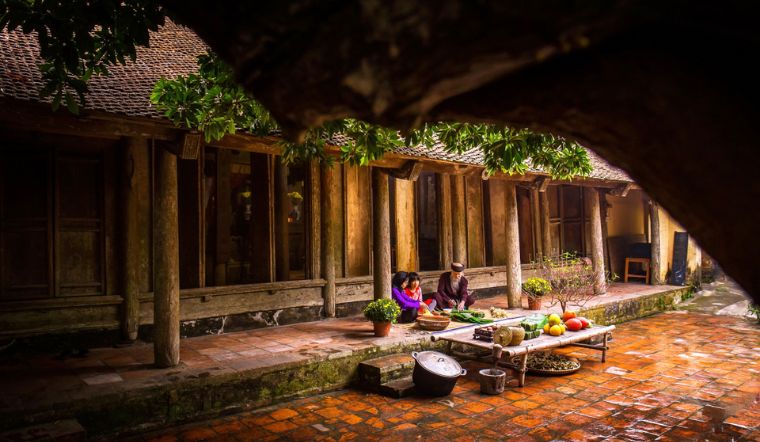
Recognized as a National Historical Monument on May 19, 2006, by the Vietnam government, Duong Lam Ancient Village stands as a living museum of Vietnam’s past. Stepping into its cobblestone streets feels like a journey back in time, where centuries-old customs and ways of life continue to thrive amidst the ever-changing landscape of modernity.
One of the village’s most striking features is its traditional layout, characterized by village gates, majestic banyan trees, tranquil water wharves, communal courtyards, ancient pagodas, and sacred shrines. The road system, with its unique herringbone shape, ensures that visitors never turn their backs on the revered Holy door as they navigate through the village.
Mong Phu village, within Duong Lam, holds particular significance. Here, visitors encounter an ancient village gate, a simple yet captivating two-roofed structure that marks the entrance to the village. Nearby stands the Mong Phu communal house, a masterpiece of traditional Vietnam architecture dating back to 1684. Its lower yard, designed to channel rainwater into two dragon-shaped drains, serves as a testament to the ingenuity of ancient builders.
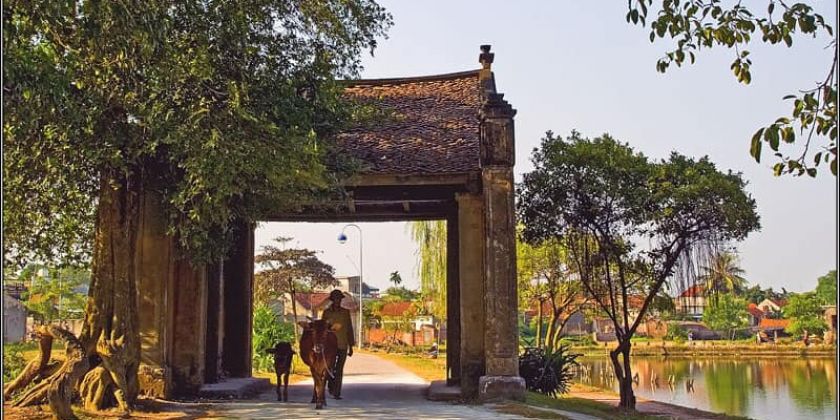
As one wanders through Duong Lam, they are greeted by a plethora of traditional houses, each telling its own story of centuries past. Dong Sang, Mong Phu, and Cam Thinh villages boast a total of 956 such houses, some dating as far back as 1649. These architectural marvels, constructed entirely from laterite blocks, stand as enduring symbols of Vietnam’s rich architectural heritage.
Bat Trang Pottery Village
Located just 10 km from the center of Hanoi in Bat Trang commune, Gia Lam district, is a serene enclave where the age-old craft of pottery thrives amidst the modern hustle and bustle. With a history spanning over 500 years, this historic village serves as a stronghold of traditional craftsmanship, safeguarding the cultural legacy of Hanoi’s traditional craft villages.
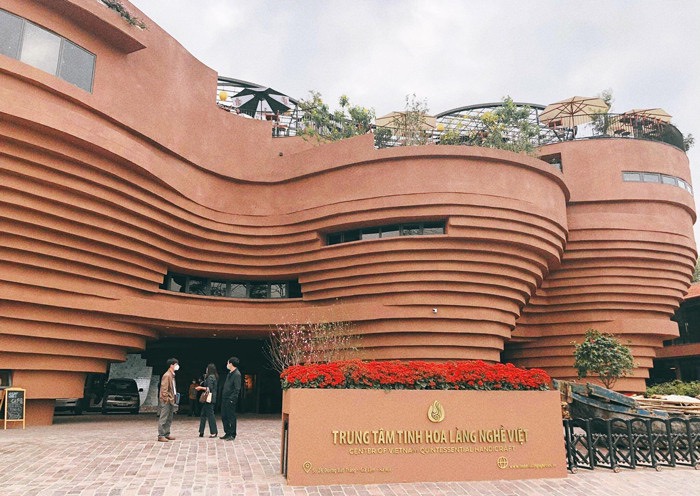
Dating back to the Ly Dynasty, Bat Trang traces its roots to the migration of five prominent pottery families from Bo Bat pottery village in Ninh Binh province to the fertile lands along the Red River. Over the centuries, the village has weathered the sands of time, evolving into a bustling hub of ceramic production renowned for its impeccable artistry and enduring charm.
Upon arrival, visitors are greeted by a labyrinth of narrow alleys flanked by moss-covered ancient houses, each bearing witness to the village’s illustrious past. Notable landmarks include the Van Van ancient house, a meticulously preserved wooden edifice with a history spanning over two centuries, and the Bat Trang communal house, a venerable sanctuary steeped in tradition and heritage.
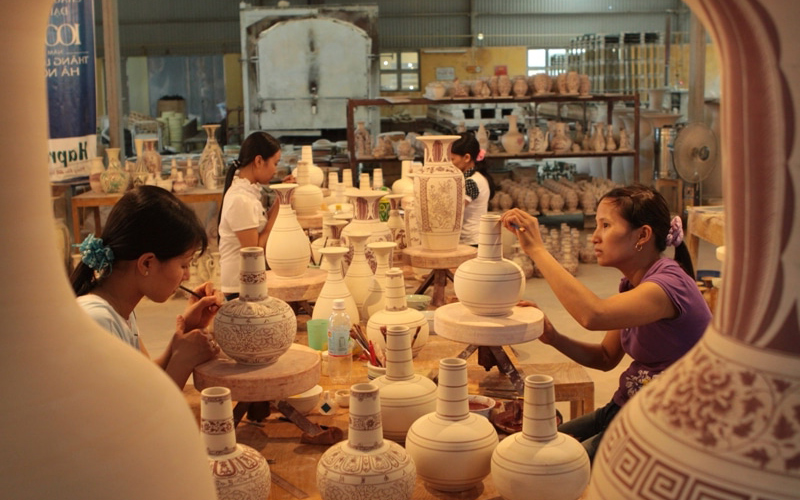
As visitors meander through the village, they encounter pottery drying racks lining the streets, walls adorned with the patina of ages, and the tranquil ambiance of communal courtyards. Yet, the crowning jewel of Bat Trang is its ancient gourd kiln, a rare relic harkening back to the village’s pottery-making heritage.
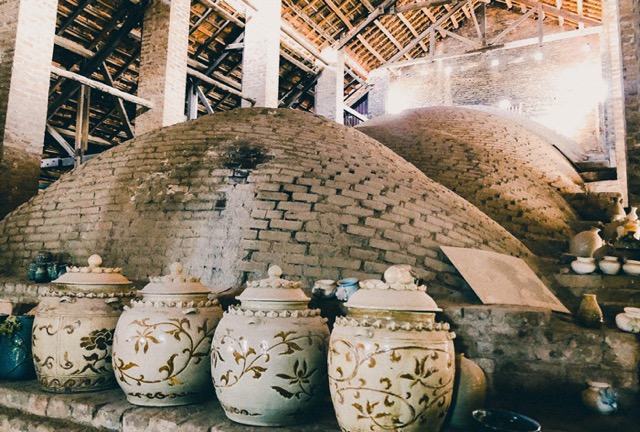
Comprising five gourds and nearing a century in age, this unique kiln stands as a testament to Bat Trang’s rich history and enduring craftsmanship. Once instrumental in firing handmade ceramics, the ancient gourd kiln now serves as a captivating attraction for visitors eager to immerse themselves in the village’s cultural heritage.
Cat Cat Village
Cat Cat Village sits nestled among the misty hills of Sapa, offering a glimpse into the traditional way of life of the Hmong people. Located just a short distance from the center of Sapa town, this charming village boasts simple wooden houses and the soothing sounds of a nearby waterfall, creating a peaceful atmosphere.
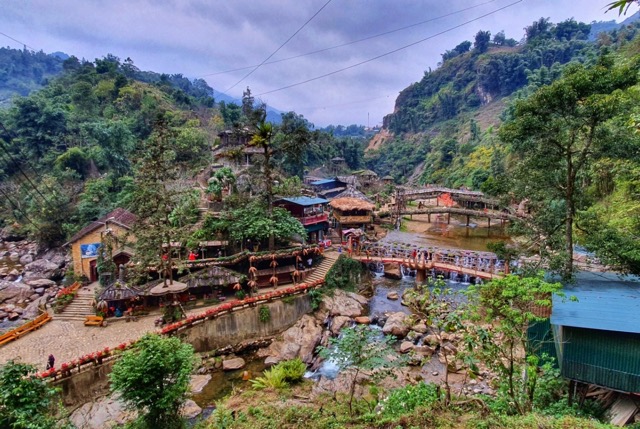
Visitors to Cat Cat Village can experience the rich cultural heritage of the Hmong community firsthand. Skilled artisans can be seen crafting intricate textiles and handicrafts, showcasing centuries-old traditions passed down through generations. It’s a great opportunity to witness traditional weaving techniques and pick up unique souvenirs.
Despite its growing popularity as a tourist destination, Cat Cat Village remains committed to preserving its indigenous architecture and landscapes. New construction projects prioritize the use of wooden materials, maintaining the village’s cultural authenticity.
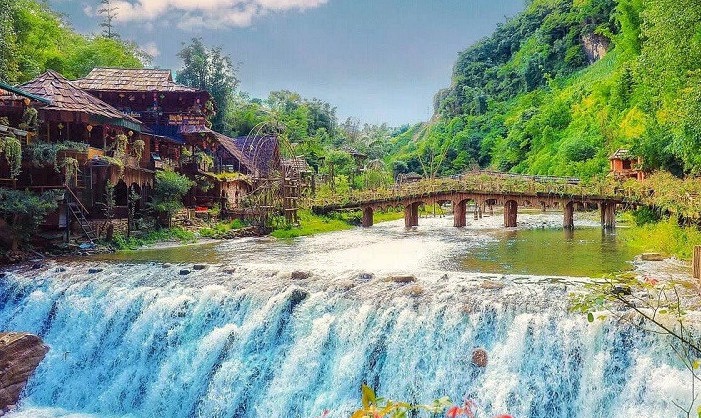
One of the highlights of a visit to Cat Cat Village is the chance to immerse oneself in the local culture. Cultural performances and demonstrations provide insight into Hmong customs and rituals, offering visitors a deeper understanding of the community’s way of life.
Van Phuc Silk Village
Embark on a journey to Van Phuc Silk Village, a hidden gem just a stone’s throw away from the vibrant streets of Hanoi. Here, amidst the tranquil surroundings of Ha Dong district, lies a haven of silk weaving tradition that has captivated hearts for centuries.
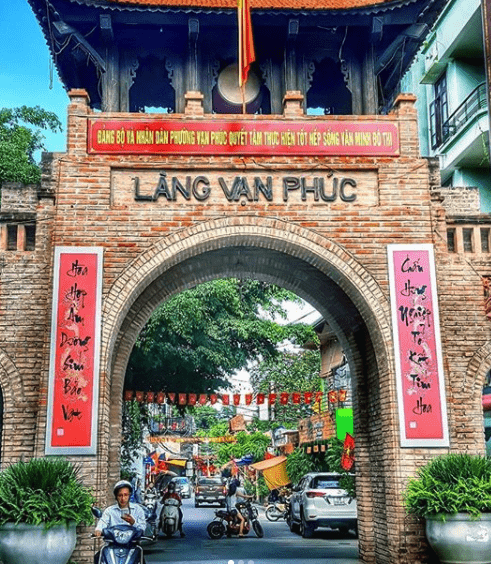
Van Phuc silk, renowned for its exquisite patterns and unparalleled quality, holds a legacy that spans thousands of years. Once favored by royalty, this luxurious fabric adorned the elite of ancient Vietnam, adding an air of elegance and sophistication to every garment.
Step into the village, and you’ll be greeted by a tapestry of sights and sounds that transport you back in time. Wander beneath the shade of ancient banyan trees, where whispers of legends and tales of bygone eras linger in the air. Marvel at the communal house yard, where the spirit of community and tradition thrives, and immerse yourself in the vibrant energy of the bustling market that springs to life each afternoon.
But it’s not just the scenery that enchants visitors; it’s the people and their passion for their craft. In Van Phuc, the art of silk weaving is more than just a skill—it’s a way of life. Families pass down ancient looms through generations, blending traditional techniques with modern innovation to create silk products that are nothing short of breathtaking.
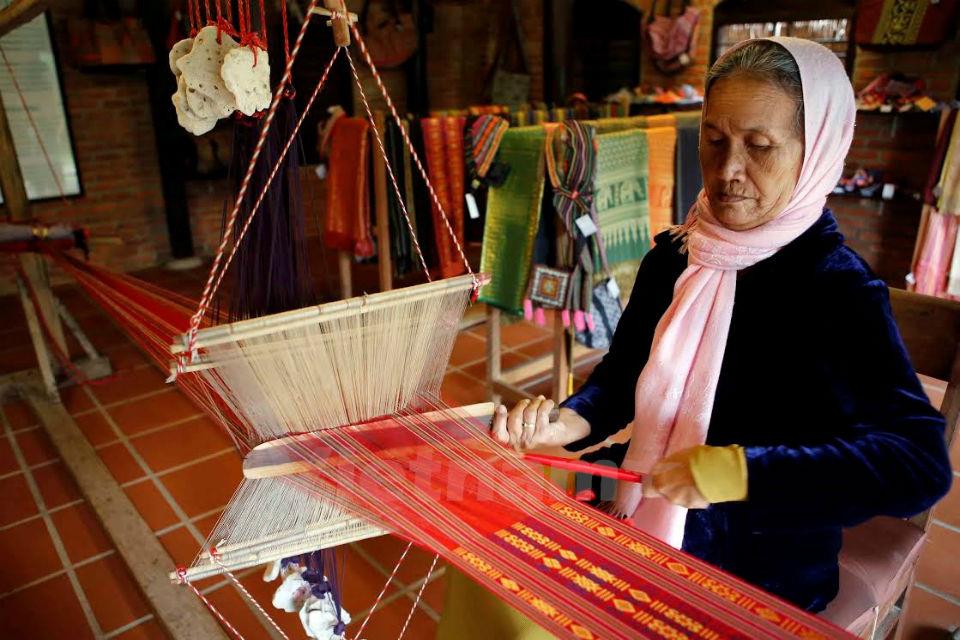
As you explore the village, you’ll find yourself drawn into the rhythmic clack of the looms, each beat a testament to the village’s unwavering dedication to its craft. Here, amidst the tranquil beauty of the Nhue River, you’ll witness artisans at work, their skilled hands weaving intricate patterns that tell stories of tradition, culture, and heritage.
Sa Dec Flower Village
Step into a world of enchantment at Sa Dec Flower Village, where the air is perfumed with the sweet scent of blooming flowers and every corner bursts with vibrant colors. Nestled along the serene banks of the Tien River, this floral paradise has been captivating hearts since the early 20th century, with its picturesque landscapes and bountiful botanical treasures.
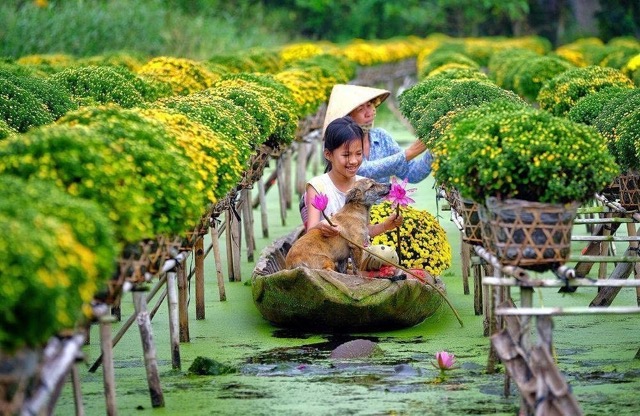
Here, amidst the poetic charm of Sa Dec, visionary cultivators like Mr. Duong Huu Tai have transformed the land into a haven of horticultural excellence. Tai’s legendary rose garden, boasting over 400 varieties of flowers and precious medicinal herbs, serves as a testament to the village’s dedication to floral perfection.
Spread across more than 783 acres of lush terrain, Sa Dec Flower Village is a sprawling oasis of natural beauty. From the tranquil streets of Tan Quy Dong Ward to the verdant expanses of An Hoa Ward, every corner of the village is adorned with the delicate blooms of over 2,000 ornamental flower varieties.
As you wander through the village, you’ll be captivated by the kaleidoscope of colors that paint the landscape in hues of red, pink, and gold. From elegant blooming trees to intricately designed ornamental leaves, each flower tells a story of craftsmanship and botanical mastery.
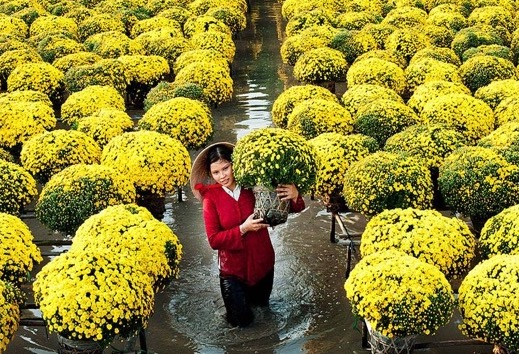
But the allure of Sa Dec extends far beyond its borders. With its reputation as one of the largest ornamental flower farms in the Western region of Vietnam, the village’s floral creations are sought after both nationwide and internationally. From bustling markets to tranquil riverbanks, the beauty of Sa Dec flowers knows no bounds.
For travelers seeking a sensory adventure, a visit to Sa Dec Flower Village promises an unforgettable experience. Lose yourself in the serenity of nature’s embrace, as you stroll through fields of blossoms and immerse yourself in the vibrant tapestry of Vietnam’s floral heritage.
Boi Khe Lacquer Craft Village
Nestled within the serene landscapes of Chuyen My commune, Phu Xuyen district, Hanoi, lies Boi Khe Lacquer Craft Village—a bastion of artistic tradition with a history as rich as its cultural heritage. Situated approximately 35 kilometers from Hanoi city center, this quaint village offers a glimpse into the time-honored craft of lacquerware production.
Boi Khe Village spans an area of about 50 hectares, with a significant portion dedicated to residential and agricultural purposes. Legend has it that the art of lacquerware in the region traces its origins back to Tran Lu, an esteemed artisan from Bang Vong village. Having journeyed to China in 1527, Tran Lu mastered the craft of lacquer making and returned to his homeland to impart his knowledge, thus laying the foundation for the village’s artisanal legacy.
Throughout the years, Boi Khe Village flourished alongside its neighboring communities, emerging as a hub for lacquer craftsmanship. In the pre-1954 era, artisans in Boi Khe primarily focused on producing worship objects, catering to religious and spiritual needs. Organized into worker guilds, these skilled craftsmen honed their craft under the guidance of master workers, creating intricate pieces that reflected their cultural identity.
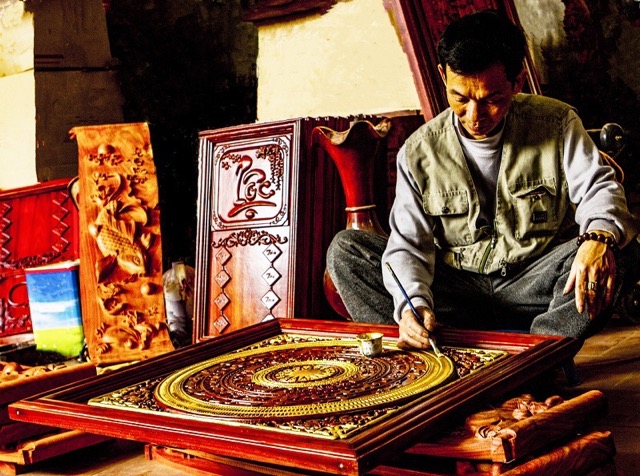
The 1960s and 1970s marked a period of prosperity for Boi Khe Village, fueled by a surge in demand for lacquerware exports to the Soviet Union and Eastern Europe. The village witnessed the establishment of multiple lacquer cooperatives, including Truong Son in Boi Khe, Ngo Ha, My Thinh in Trung village, and Hop Thanh in Thuong village. However, the collapse of the Soviet Union in the early 1990s dealt a blow to the lacquer craft industry, leading to a temporary halt in production.
Despite the challenges, Boi Khe Village experienced a resurgence in the late 20th century, with efforts to revive and modernize the traditional craft. Since 1996, the village has witnessed a steady revival, with artisans embracing innovation while preserving the time-honored techniques passed down through generations.
Today, visitors to Boi Khe Lacquer Craft Village can immerse themselves in the beauty of this ancient art form, witnessing firsthand the meticulous process of lacquerware production. From ornate decorative pieces to functional household items, each creation is a testament to the village’s enduring legacy of craftsmanship and creativity.
Vung Vieng Fishing Village
Nestled within the idyllic Bai Tu Long Bay, approximately 20 kilometers northeast of Tuan Chau port, lies Vung Vieng Fishing Village—a hidden gem renowned for its serene natural beauty and tranquil atmosphere. Far removed from the bustling city life, this small, isolated village offers travelers a peaceful retreat amidst the stunning backdrop of pristine landscapes.
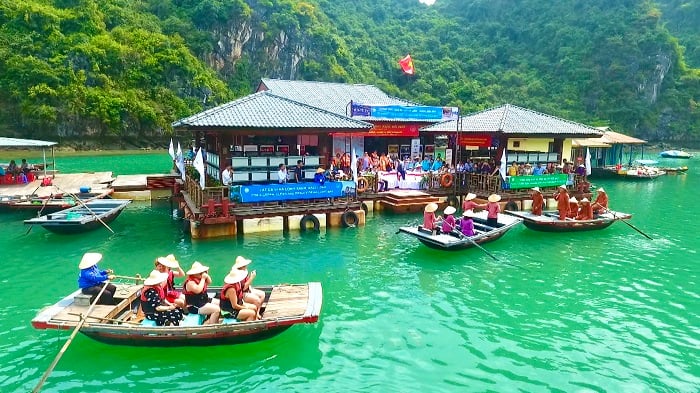
Stepping foot into Vung Vieng, visitors are greeted by a scene straight out of a postcard—a picturesque village where time seems to stand still. Dating back to the 19th century, Vung Vieng was established by ancient fishermen who anchored their ships here, forming a close-knit community centered around friendship, trade, and camaraderie.
Today, Vung Vieng is home to approximately 50 multi-generational families, totaling around 300 residents. Fishing remains the primary livelihood, with locals relying on the bounties of the sea for sustenance. Life in the village revolves around wooden and bamboo rafts that float gracefully along the river, creating a vibrant tapestry of colors against the serene waters.
Despite the challenges they face, the people of Vung Vieng exude a spirit of resilience and positivity that is palpable to visitors. Their floating houses, though modest, are spacious and clean, offering a glimpse into the simple yet fulfilling way of life in the village.

Compared to other fishing villages in the area, such as Ba Hang, Cua Van, and Cap La, Vung Vieng sees fewer tourists, making it an ideal destination for those seeking solitude and tranquility. Here, the air is crisp, the waters are calm, and the pace of life is refreshingly slow—a welcome respite from the hustle and bustle of modernity.
In addition to its natural beauty, Vung Vieng boasts a vibrant community spirit, with a communal house serving as a gathering place for locals and a marketplace for handicrafts and souvenirs. For travelers, it offers a unique opportunity to immerse themselves in the rhythms of village life, forging connections with locals and gaining insight into traditional fishing practices.
Cam Thanh Village
Just 5 kilometers from the bustling old town center lies the serene oasis of Cam Thanh Village—a hidden gem awaiting discovery by adventurous travelers. Nestled between Tam Ky City, located 40 kilometers away, and Da Nang City, just 30 kilometers away, Cam Thanh Village is renowned for its breathtaking nipa palm forest—a haven of historical, cultural, and ecological significance.
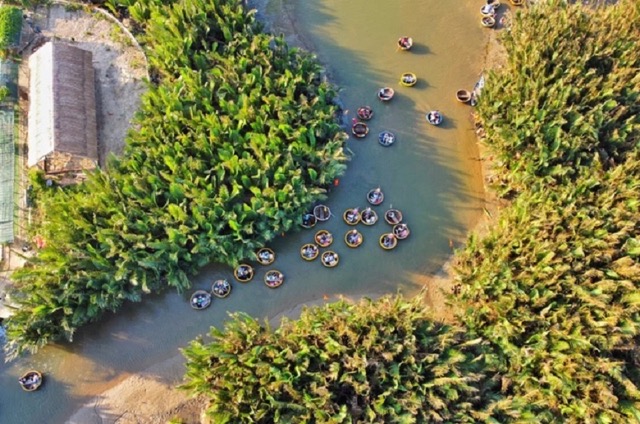
Boasting a rich biodiversity of riverside and sea wetlands, the village’s nipa palm forest offers visitors a captivating glimpse into nature’s wonders. Embark on a leisurely boat ride through the mangrove-lined waterways, where the Thu Bon River meets the sea, or opt for a scenic bicycle tour through verdant rice fields, basking in the cool, refreshing breeze of the countryside.
Surrounded by rivers on all sides, Cam Thanh Village is a picturesque enclave teeming with natural beauty. To the north, the Ba Chuom River borders the village with Cua Dai Ward, while to the west, the Do River demarcates its boundary with Cam Chau Ward. To the south, the lower reaches of the Thu Bon River separate the village from Duy Xuyen District, while to the east, the Cua Dai Dinh River and Do River intertwine, creating a labyrinthine network of waterways.
This intricate system of rivers and canals weaves its way through lush fields, muddy flats, and quaint villages, offering a glimpse into the daily lives of local residents. Along the banks, majestic nipa palm trees stand sentinel, their lush green foliage providing both a picturesque backdrop and vital protection against the elements.
For centuries, these resilient trees have shielded the village from the ravages of nature, serving as a steadfast guardian of the land and its people. Today, they continue to envelop Cam Thanh Village in their protective embrace, a testament to the enduring bond between humanity and nature.
Conclusion
In conclusion, Vietnam’s villages offer a rich tapestry of cultural heritage, from the ancient traditions of Duong Lam to the intricate craftsmanship of Bat Trang. Whether exploring the vibrant markets of Sadec Flower Village or marveling at the natural beauty of Cua Van Fishing Village, each destination promises a unique and immersive experience. As travelers venture into these quaint settlements, they discover not just the history and traditions of Vietnam, but also the warmth and hospitality of its people.


Related Posts
Saigon’s “Flower Market Replica”: Where To Find Them
Ho Chi Minh City’s floral charm is not limited to its bustling wholesale markets. Imagine wandering through a place where vibrant petals, fragrant blooms, and the spirit of traditional Vietnamese markets come alive—without the overwhelming crowds. A flower market replica captures that magic, blending the beauty of fresh flowers with the charm of a curated, […]
Is it Safe to Travel to Vietnam Right Now? A Complete 2025 Guide
Vietnam has emerged as one of Southeast Asia’s most captivating destinations, drawing millions of visitors annually with its rich culture, stunning landscapes, and incredible cuisine. However, many travelers still ask: Is it safe to travel to Vietnam right now? This comprehensive guide provides you with everything you need to know about Vietnam travel safety in […]
Ho Chi Minh Cu Chi Tunnels Tour: The Ultimate Guide
The Cu Chi Tunnels stand as one of Vietnam’s most remarkable historical sites, offering visitors a profound glimpse into the ingenuity and resilience displayed during the Vietnam War. For travelers, a Ho Chi Minh Cu Chi tunnels tour represents an essential experience that combines education, adventure, and deep cultural understanding. This comprehensive guide will help […]